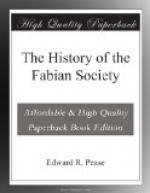My own connection with the Society also changed. In the spring of 1886 I gave up my business on the Stock Exchange and in the summer went to Newcastle-on-Tyne, where I lived till the autumn of 1890. My account of the Society for the next three years is therefore in the main derived from its records. Sydney Olivier succeeded me as “Acting Secretary,” but for some months I was still nominally the secretary, a fact of much significance to my future, since it enabled me if I liked to deal with correspondence, and it was through a letter to the secretary of the Society, answered by me from Newcastle, that I made the acquaintance of the lady who three years later became my wife.
FOOTNOTES:
[10] “Misalliance: with a treatise on parents and children,” 1914.
[11] Industrial Remuneration Conference. The Report, etc. Cassell, 1885, p. 400.
[12] William Clarke had attended some early meetings but dropped out and was actually elected to the Society in February, 1886.
[13] Presumably a “Times” reporter was present; but his report was not published.
[14] Later M.P. for Tyneside and a member of Mr. Asquith’s Government.
[15] Contemporary accounts of the conference can be found in the July numbers of “To-day” and “The Republican,” the former by Mrs. Besant, and the latter, a descriptive criticism, by the Editor and Printer, George Standring.
Chapter IV
The Formation of Fabian Policy: 1886-9
The factors of success; priority of date; the men who made it—The controversy over policy—The Fabian Parliamentary League—“Facts for Socialists”—The adoption of the Basis—The seven Essayists in command—Lord Haldane—The “Essays” as lectures—How to train for Public Life—Fabians on the London School Board—“Facts for Londoners”—Municipal Socialism—“The Eight Hours Bill”
The Society was now fully constituted, and for the next three years its destiny was controlled by the seven who subsequently wrote “Fabian Essays.” But it was still a very small and quite obscure body. Mrs. Besant, alone of its leaders, was known beyond its circle, and at that period few outside the working classes regarded her with respect. The Society still met, as a rule, at the house of one or other of the members, and to the founders, who numbered about 20, only about 67 members had been added by June, 1886. The receipts for the year to March, 1886, were no More than L35 19s., but as the expenditure only amounted to L27 6s. 6d., the Society had already adopted its lifelong habit of paying its way punctually, though it must be confessed that a complaisant printer and a series of lucky windfalls have contributed to that result.
[Illustration: From a photograph by Elliott and Fry, W.
SYDNEY OLIVIER, IN 1903]




